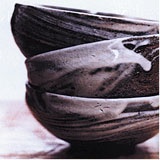 Jim Franco
In Tokyo, the new wave in ceramics is a fusion of tradition and the cutting edge
Jim Franco
In Tokyo, the new wave in ceramics is a fusion of tradition and the cutting edge
More than 400 years ago what we now think of as Japanese pottery began to take form. The tradition is based on a strong sensitivity to the harmony of foods and the dishes used to serve them; even mundane edamame beans are presented in beautiful shallow bowls produced specifically for the task.
But the unspoken code that has long dictated the relationship between form and use is being challenged. I first noticed the change on the tables of Tokyo's fusion restaurants, whose menus had surrendered to the "Nobu Effect," embracing other Asian and Western cuisines. The old pottery forms no longer suited this hybrid fare, so a crossover style of pottery was created, incorporating Western shapes and unusual proportions. The drift has spread to the home — while the previous generation might have aspired to a set of delft, there is now a tendency to adapt the traditional arts to a contemporary lifestyle.
The Tokyo shops that carry this emerging tableware are run by devout ceramic lovers. I'm partial to my "local," Marco Polo (1-36-13 Uehara, Shibuya-ku; 81-3/3466-1523), in the expat-heavy Yoyogi-Uehara district. Owner Masumi Narita bravely answers questions from English-speakers; her shop reflects her confidence. On a cluttered center table, she mixes machine-made pieces with the handmade. Potters found by Narita at shows and craft exhibitions are often on display next to the rare object by an established master. There are also eclectic textiles, including throw pillows sewn from antique kimonos.
Nearby is Kou (1-1-19 Uehara, Shibuya-ku; 81-3/3398-9679), unique in that it represents the work of only one artist, Tsuneko Tanaka. Owner Hiroyuki Tanaka, the designer's husband, claims that his wife was the first proponent of the crossover style, referencing a beer mug she produced more than 15 years ago. This past season's works were coated with a thick, glossy cream glaze. Teacups, large enough to be used as water glasses, were ornamented with a simple band of white around the midsection.
Junko Toda, owner of Tsuchi-No-Hana (5-11-22 Minami-Aoyama, Minato-ku; 81-3/3400-1013), in the tony Aoyama neighborhood, shows tableware produced from fine porcelain clay. The pieces with paper-thin edges are elegant in their simplicity. With his amazing eye for presentation, Toda fills delicate vases with freshly cut plum or cherry blossoms. Standout pieces are by the young potter Yasushi Fujihira, who pounds circles of clay into plates with his palm. Beneath the crackled celadon is the faint imprint of the artist's hand.
The feel is entirely different at Toukyo (20-5-13 Nishi Azabu, Minato-ku; 81-3/3797-4494), a dark and crowded shop in the fashionable Nishi Azabu neighborhood. Owner Ichiro Hirose prefers coarse stoneware, and the cavelike environment suits these pieces, which seem to have come directly from the ground. An oversize bowl of unglazed yellow clay is pitted with small pebbles.
In swinging Harajuku, where platform heels reach stratospheric heights, it's suddenly cool for the younger generation to collect contemporary ceramics. At the basement shop Zakka (6-28-5 Jingumae, Shibuya-ku; 81-3/3409-6768), a limited number of pieces are presented on wooden shelves anchored into concrete walls and on two long farmhouse tables. Thick plates by the artist Shoji Onzuka look like dollops of pancake batter just ladled onto the griddle.
Farther west, as the city morphs into the suburbs, is Party (2-9-2 Komaba, Meguro-ku; 81-3/3467-6830), which feels like someone's kitchen. Owner Sayomi Sakane can often be seen cooking on a small stovetop in the corner, and doesn't think twice about grabbing a plate off the shelf to use for her lunch. She refers to the works for sale as utsuwa, or containers to showcase food—to her, they're a way to incorporate beauty into daily life.
More refined are Daimonji (5-48-3 Jingumae, Shibuya-ku; 81-3/3406-7381) and Savoir Vivre (Axis Bldg., 3rd floor, 5-17-1 Roppongi, Minato-ku; 81-3/3585-7365), high-end boutiques where you'll find the perfect wedding gift. While the porcelain leans toward the conservative, both shops carry a few avant-garde creations. Daimonji's condiment dishes are great for holding jewelry or change.
On every foreigner's pottery itinerary is Gallery Shun (Sun Palace Bldg., 1st floor, 4-2-49 Minami Azabu, Minato-ku; 81-3/3444-7665), which recalls a 19th-century tea shop. The entrance opens onto a stone pathway leading to a showroom where a new artist is featured each week. At the gallery's restaurant, food is served on antique Imari-ware—a remarkable contrast to the modern work on display. During the warmer months, owner Yuki Yoshiaki shows work at Gallery Muu (Muudani, O-izumi-mura, Kitakoma-gun, Yamanashi Prefecture, 81-551/380-061), her converted farmhouse an hour's drive out of the city. The gallery displays Yoshiaki's whole stable of artists—manna for the pottery-obsessed.